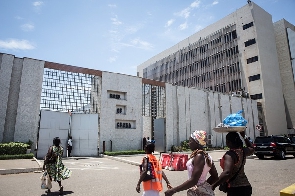Just when I felt I had done justice to explaining how banking business differs from other businesses, I was jolted to come up with further expositions to clarify some public misconceptions about the nature of the assets and liabilities of a bank and how a seemingly strong bank may simply be existing on straw.
This has become necessary in view of an article I read elsewhere that sought to justify why a certain bank need not have collapsed, because it apparently had a long and beautiful list of valuable assets, including magnificent buildings, loan facilities and investments with notable clients.
Mismatching of assets and liabilities
Interestingly, the article failed to mention the liabilities of the same bank and their composition or respective tenors to throw light on the concept of mismatching which is a key principle in the management of banks.
Mismatching is intrinsically a feature of banking business. A serious and extended period of mismatching of assets and liabilities can, however, throw a bank into insolvency, irrespective of how imposing its buildings and fleet of vehicles, and other assets appear to the untrained eye.
Mismatching must be tolerated within the regulatory framework, the bank’s risk appetite levels and prevailing market conditions. It is a risk that directly affects solvency if not expertly managed.
Illiquidity as a function of time
It is instructive to note that a bank could be profitable yet illiquid. A bank facing an extended period of illiquidity can easily collapse, irrespective of the array of assets it claims to have at any particular time since banking thrives on liquidity. Liquidity anchors the bank’s stability and provides the source of the trust that customers have in the bank.
A local joke has it that when your creditors are demanding repayments for long outstanding debts in Accra, it is not enough to boast of how many horses you have in northern Ghana.
The deleterious effects of COVID-19 on the operations in the aviation and hospitality sectors globally amplify the place of liquidity even in these sectors which are traditionally pivoted on the holding of massive fixed asset infrastructure.
In the face of dwindling patronage, the possession of a large fleet of expensive aircraft or cruise ships provides little comfort if this does not generate sustainable incomes to defray the usually high overhead costs. A similar situation occurs with large hotel chains experiencing long periods of poor or zero patronage.
Compared to the banking sector, this becomes even more tragic where the inability to pay demand deposits as and when depositors require them can easily crush a bank, irrespective of how grandiose its head office and other fixed asset infrastructure appear to the public.
The capacity of a bank to sustainably make profits and simultaneously solidify its strength to absorb shocks can be evaluated on its liquidity, or its ability to meet cash and collateral obligations without incurring substantial losses. A Capital Adequacy ratio is a widely used metric for determining the bank’s solidity.
Basel Conventions on Capital and Liquidity.
Basel 111 and 1V, in their simplest terms reinforce the need for banks to not only have adequate capital, but “adequate liquidity” at all times. Some of the key unresolved issues are how much capital is adequate and whether the need for adequate buffers (reserves) should cover all kinds of banks without distinction. Some even question if bankers are not being paranoid about how much reserves will provide the necessary cushions to avoid insolvency.
A distinction is also made between economic and regulatory capital. Where the latter diminishes below minimum levels, additional capital injection by shareholders is required or debt capital acceptable to the regulator in terms of quantum, tenor and conditions of borrowing will be required or the bank’s licence may be under threat.
Large or continuous losses may deplete capital and imperil the licence which technically, is held at the mercy of the regulator.
Beyond the capital, liquidity is the lifeblood of a bank. A prime objective of liquidity management is an enhancement of the bank’s ability to anticipate and accommodate deposit and other liability impairments and at the same time fund growth in the loan portfolio and other off-balance sheet exposures.
The Bank’s ALCO
The Assets and Liability Committee of a bank is one of the units any bank operating under Act 930 must have. This body assesses the liquidity position of the bank by placing all the assets and liabilities of the bank into specific or desirable buckets and analyzing the net liquidity or cumulative position for each maturity band. This is called a liquidity ladder.
The resultant gap which could be positive or negative depicts the liquidity or cash position of the bank at any given time. A negative cash position can be changed into desired levels by liquidating the marketable assets portfolio hence, the need to maintain optimum levels of such tradable instruments. There is a trade off between excess liquidity and profitability, though.
The ALCO determines the cost of liquidating such assets in case of need. Liquidity could also be sourced from fresh liabilities and new capital injection, securitization or leasing arrangements that release tied up capital into cash flows. When all these measures fail, the bank may approach the central bank for extended liquidity assistance. This is expected to be temporary in nature.
Assets Quality Review
When this critical function of the bank fails, the bank would be thrown into crises, irrespective of how strong it may appear to the unsuspecting public. The Bank of Ghana’s Asset Quality Review is replete with evidence that most, if not all, the banks that collapsed had been on this liquidity support for longer than could be tolerated by the central bank. Some of the banks were even noted to have dissipated these funds on non-core businesses.
Another critical factor that does not usually appear in the public domain when discussing the solvency of a bank is the quality of its assets, especially the loans portfolio. Banks A and B may respectively have the same GHS. 10 billion as the total of their loan book in their balance sheets on the same date.
It is still possible that Bank A may collapse in six months as a result of the hiccups it may experience in loan recoveries due to the fact that 50% of this portfolio sits with the aviation and hospitality sectors which are reeling from the effects of COVID-19.
Bank B conversely may be more profitable and liquid because it has the same concentration of assets held by borrowers in the pharmaceutical industry. This simple illustration should convince the general public of the concentration risk facing different banks and why the regulator would insist on “a fair balance of risk appetite” by ensuring Single Obligor Limits and sectoral concentration risks.
It is therefore cold comfort for a bank’s management to revel even in their holdings in subsidiary companies when these do not generate enough cash flows but simply live off preferential loan facilities from its principal shareholders.
The new rules that preclude a financial institution from having non- financial subsidiaries stem from this risk which was the bane of some of the collapsed banks.
The ageing of a bank’s portfolio also has an effect on its profitability and cash flows. Whenever loans are granted, the bank is obliged to make provision for bad debts according to clearly defined criteria that hinge mainly on how long repayments have remained outstanding.
The longer the period of default by the counter party, the higher the provision that must be made to cover the potential loss. This has huge implications on the bank’s profitability as it directly impacts the income statement and cash flows needed for recycling.
SOURCES OF LIQUIDITY RISK
Weak liquidity management arising from a failure to properly forecast imminent financial obligations or laddering of the various assets and liabilities may precipitate a liquidity crisis. This may arise from poor monitoring of the bank’s positions in the various assets and liabilities classes and also the various currencies it is exposed to.
Off-balance sheet exposures can also be a serious source of illiquidity for a bank.
Contingent liabilities that are not properly provided for or anticipated can derail the bank’s liquidity, hence the recommended treatment as suggested by IFRS 9.
Even more crucial is a major credit risk event. A typical scenario is what some of the major banks suffered in the case of the Finatrade loan losses and generally the loan write-offs occasioned by the combined effects of the energy companies’ indebtedness to the banks.
Regulatory write-down of the loan portfolio following inspection/audit by the Regulator could have similar liquidity effects. The GCB Bank Limited’s massive write-downs of the Tema Oil Refinery debt situation in 2011 is a typical example.
Having identified the key sources of a liquidity crunch, the individual banks apply the strategies that would adequately respond to the factors, if they are internal, while the Central bank and the fiscal authorities drive the external factors to ensure sanity in the market.
Regulatory intervention
The central bank can be likened to an impartial, responsible and knowledgeable referee in a football game. The referee’s prime objective (if it has not been tainted by corruption) is to ensure that all players and officials play according to pre-agreed set of rules to make the game pleasurable and to elicit the desired patronage of fans and other stakeholders.
The central bank grants emergency liquidity assistance to prop up an ailing bank. This is not a gift to the recipient bank but designed to shore up the bank’s liquidity temporarily and with conditions.
In most of the cases under reference, this situation became hard core, worsened by grave corporate governance infractions where facilities were allegedly granted to directors in blatant conflict of interest situations. Other facilities went to related parties and friends and cronies of directors.
Even with gifts, sometimes the giver may be interested and possibly determine the secondary recipients and the general purpose for which the funds are applied. This is to ensure that the mode of application of the gift is congruent to the original intentions of the primary giver.
Emergency liquidity assistance in the realm of financial market stabilization cannot by any definition be termed as a gift to the beneficiary bank. It is designed primarily to support banks in temporary liquidity stress so that they do not renege on their traditional promises to meet customers’ withdrawals on demand. The disbursement is by all intents and purposes, a loan facility, albeit for a short period, against defined objectives and pre-conditions set by the central bank.
When a particular bank persistently borrows on the money market, other market participants begin to be wary of the consistent borrower.
The situation becomes even perilous when the borrowing bank begins to offer significantly above market rates for their borrowing needs in desperation. That itself is a signal of the depth of distress and would arise when the central bank pushes the ailing bank to source the latter’s needs from the market instead of relying on the regulator. This measure would be a means to ensure that the appropriate market rates prevail.
The central bank’s principal reason for assisting the ailing bank is to avoid contagion effects where the ailing bank’s inability to service debts owed to other universal banks can trigger unforeseen consequences in the entire financial system.
When liquidity shortages persist, they are often symptoms of deeper problems plaguing the bank concerned. Chances are that the bank is facing high non-performing loans ratio which is depressing their liquidity and profitability. It could also mean that there is a massive mis-match between assets and liabilities where the universal bank has used short term deposits to fund long term assets, like the alleged equity investments in other banks or a multitude of subsidiaries which has drained its liquidity.
From my previous experience, each time I observe a bank with so much resources stacked up in non- earning assets like a fleet of vehicles, expensive premises and other fixed/immovable assets, I simply ask myself if the Board and management really understand the concept of liquidity management.
At a time when Base 1V seeks to strengthen liquidity management even further, it would be disastrous for a bank, especially a fairly new bank, to invest disproportionately in non-earning assets. GCB Bank Limited can ride this storm in respect of its numerous branches because most of them have been fully depreciated, anyway.
It comes as a surprise therefore that a bank on life support would itself share its oxygen with other siblings or grandchildren and the central bank could not detect such infractions of the related party rules before things degenerated. Some of these infractions border on mischevious machinations to avoid detection until all the packs were blown off by the Asset Quality Review, rather belatedly.
It is a sad commentary therefore for one to ask “ since when did the Bank of Ghana arrogate to itself who a universal bank lends to?”. One only needs to re-read the anti-money laundering legislation and the global push to tackle this menace to answer that apparently frivolous question because banking business cannot be conducted anyhow. It becomes even more pertinent when a bank is existing on emergency liquidity assistance and still engaged in bad lending practices.
In which jurisdiction would a banker not be interested in how borrowed funds are applied?
It defies economic and governance sense to suggest that when a regulator is continually supporting an ailing bank, that same lender still has no business being interested in how the extended assistance to the recipient bank is applied.
Any diligent and smart relationship manager in a universal bank would be expected to ensure that a borrowing client is using the loan funds disbursed according to the original purpose of the loan. This person must gauge the ultimate beneficiaries of the customer’s cheques passing through the account.
Why would anyone suggest that the regulator cannot do similarly when it offers liquidity assistance which must be ring-fenced to avoid capricious dissipation as we are now being told?
One of the key roles of the central bank is to employ various stress tests to assess the shock absorption capacities of the individual banks, in particular, the quantum of primary and marketable assets relative to the structure and quantum of its deposit and other contingent liabilities.













